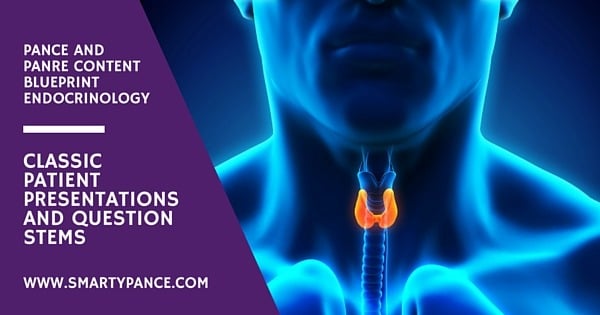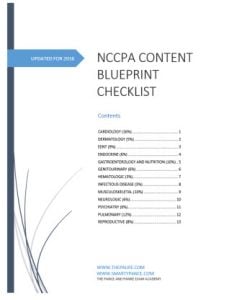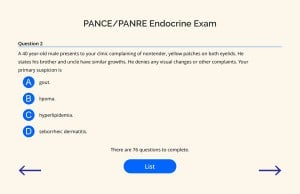Endocrinology Content Blueprint Classic and Pathognomonic Patient Presentations and Question Stems
The most common PANCE and PANRE board review question stems and patient presentations you are likely encounter on your board exam

- These represent the most common/classic patient presentations or what could be considered pathognomonic
- This is a comprehensive list following the exact NCCPA PANCE and PANRE Endocrinology content blueprint
- The Endocrinology section represents 6% of your PANCE/PANRE board exam
- Make sure to download my FREE content blueprint checklist
- Members have access to the comprehensive 76 question endocrinology exam
Endocrinology NCCPA™ PANCE and PANRE Content Blueprint Most Common Patient Presentations and Question Stems
Diseases of the Thyroid Gland |
|
| Hyperparathyroidism | Patient will present with → bones, stones, abdominal groans and psychic moans |
| Hypoparathyroidism | Patient will present with → signs of ↓ Calcium: carpopedal spasm (Chvostek's and Trousseau's sign), perioral paresthesias, ↑ DTR |
| Hyperthyroidism | Patient will present with → presents with chest pain, palpitations, weight loss and exophthalmos |
| Hypothyroidism | Patient will present with → weakness, dry skin, lethargy, cold intolerance, constipation, coarse hair, and weight gain |
| Thyroid neoplastic disease | Patient will present as → 40-60 year old female with a hoarse voice, painless neck swelling and a palpable, single firm nodule. The US will show nodule greater than 1 cm, microcalcifications, irregular margins and no iodine uptake on radionuclide scan. |
| Thyroiditis | Patient will present with → neck tenderness preceded by a viral illness (will likely be a URI) a few weeks earlier. |
Diseases of the Adrenal Glands |
|
| Corticoadrenal insufficiency (Addison's Disease) | Patient will present → complaining of extreme weakness, 20-lb weight loss, lightheadedness, and dizziness. On physical exam, the patient appears ill, and his blood pressure is 90/70 mm Hg. He has dark skin and hyperpigmented creases on his palms. Serum sodium is low, potassium is elevated; urea level and serum calcium are both elevated as well. |
| Cushing syndrome | Patient will present with → buffalo hump, moon facies, pigmented striae, obesity, skin atrophy, hypertension, weight gain, hypokalemia
Why weight gain? Cortisol stimulates fat and carbohydrate metabolism for fast energy, and stimulates insulin release and maintenance of blood sugar levels. The end result of these actions can be an increase in appetite |
| Adrenal Neoplastic disease (pheochromocytoma) | Patient will present with → hypertension as well as a triad of headache, palpitations, and sweating |
Diseases of the Pituitary Gland |
|
| Acromegaly/gigantism | Patient will present with → A 45-year-old woman presented with a 4-year history of progressive increase in body size, lactation and amenorrhoea, and a six-week history of worsening symptoms of heart failure. Physical examination showed coarse facial features, spade like hands and feet, pitting pedal edema, galactorrhoea, and features of congestive cardiac failure. Chest radiograph showed gross cardiomegaly. On skull radiograph, destruction of the floor of the pituitary fossa was noted, with erosion of the clinoid processes. She had hyperprolactinemia. Fasting and post-glucose growth hormones values were elevated. |
| Diabetes insipidus | Patient will present → with polyuria, weight loss and recent seizures |
| Pituitary dwarfism (GH deficiency) | Patient will present with → growth below the 5th percentile, delayed bone maturation, X-ray showing late closure of epiphyseal plates |
| Pituitary adenoma and Neoplastic disease | Patient will present with → visual changes (temporal field loss - bitemporal hemianopsia due to pressure on the optic chiasm from enlarging pituitary), along with headache and hormonal abnormalities. |
Diabetes Mellitus |
|
| Type 1 | Patient will present as → a young patient with weight loss, increased thirst and urination. The patient has felt tired and nauseous. On examination her weight is below the 5th percentile, she looks thin, and her skin is pale. her blood pressure is 100/70 and her pulse is 104 bpm. Her respirations are deep at a rate of 28 breaths/minute. Her breath smells fruity |
| Type 2 | Patient will present with → a 35 year old Mexican American male presents to your office complaining of increased thirst, frequent urination, hunger, fatigue, and blurred vision random finger stick blood glucose is 225 |
Lipid Disorders |
|
| Hypercholesterolemia | Patient will present with → usually asymptomatic and is identified on routine screening or during first cardiac event. |
| Hypertriglyceridemia | Patient will present with → The majority of the time, hypertriglyceridemia is discovered after performing a routine lipid profile. However, severe hypertriglyceridemia (>500 mg/dL) may cause pancreatitis, eruptive xanthomas, or lipemia retinalis |






